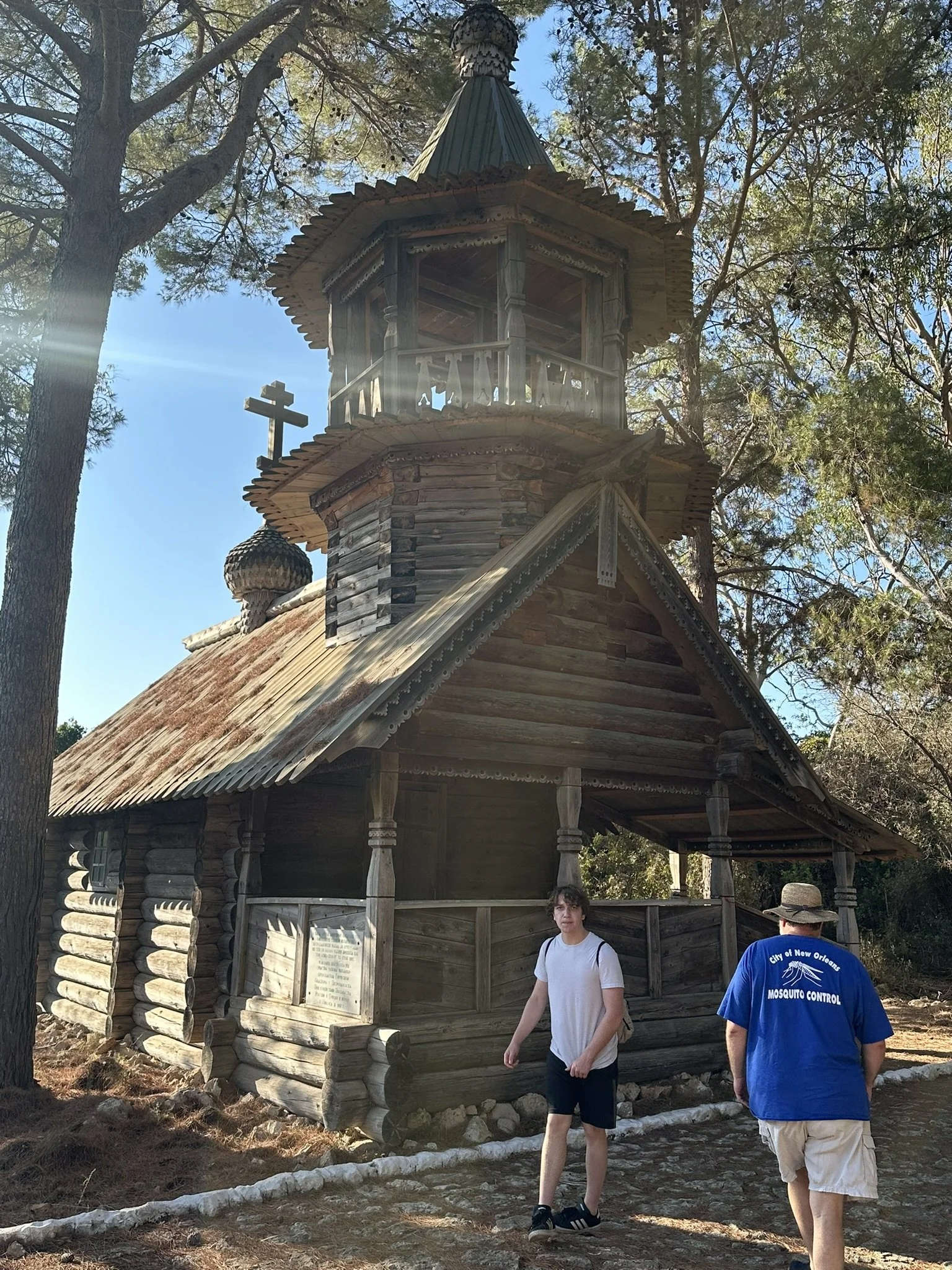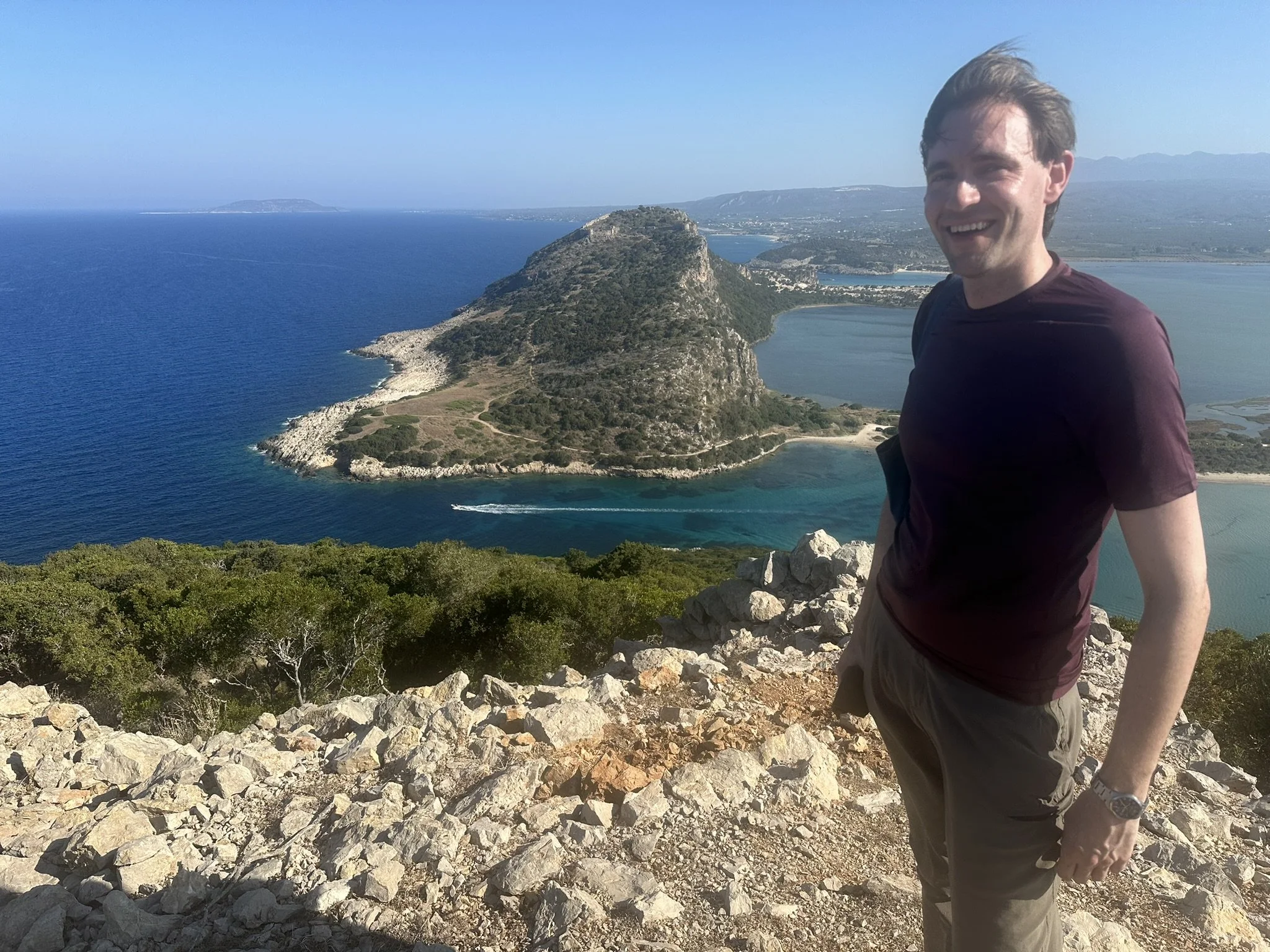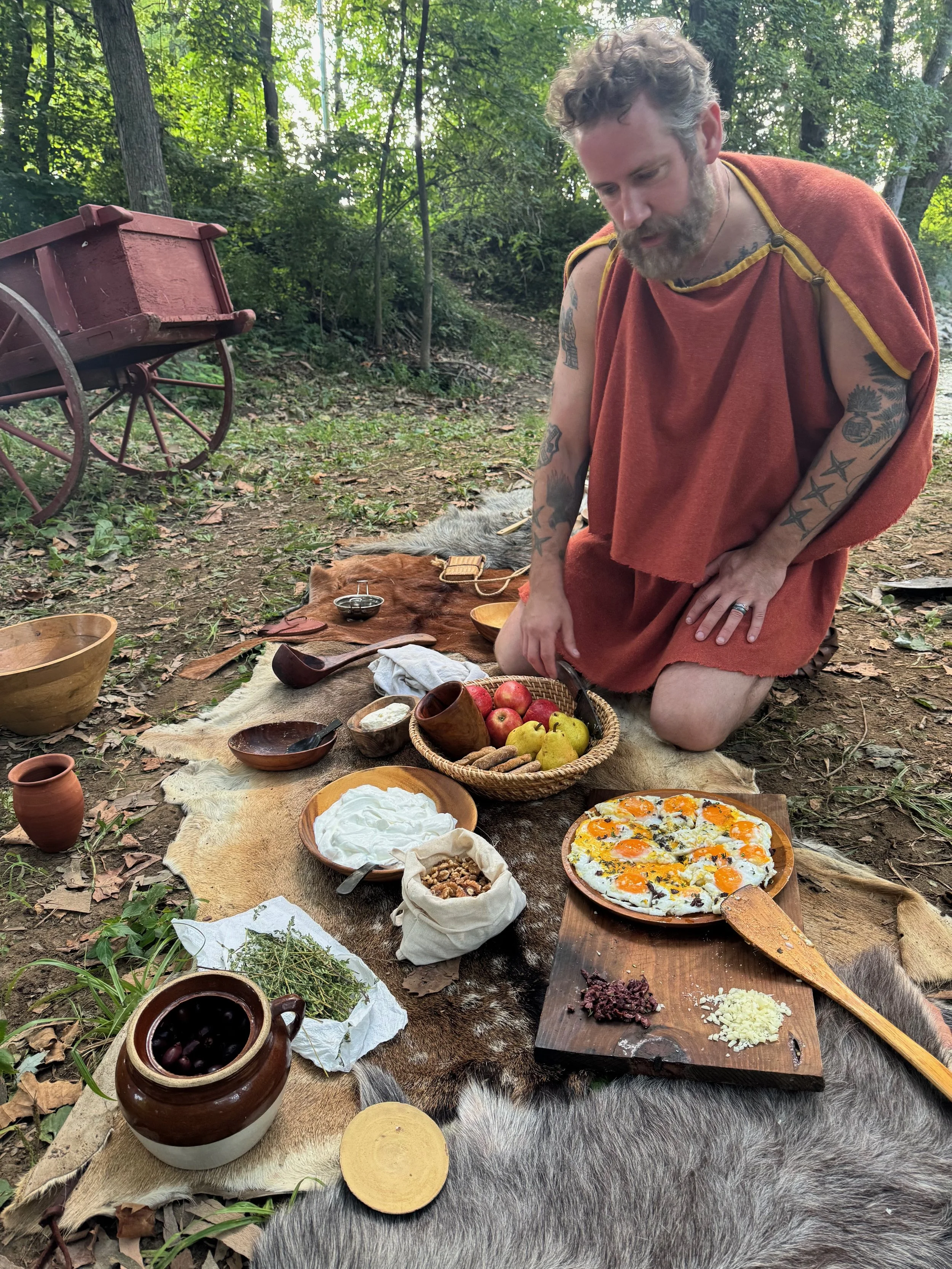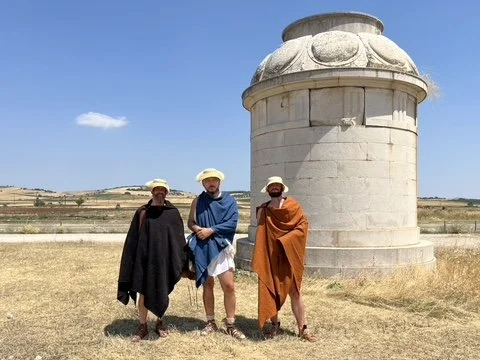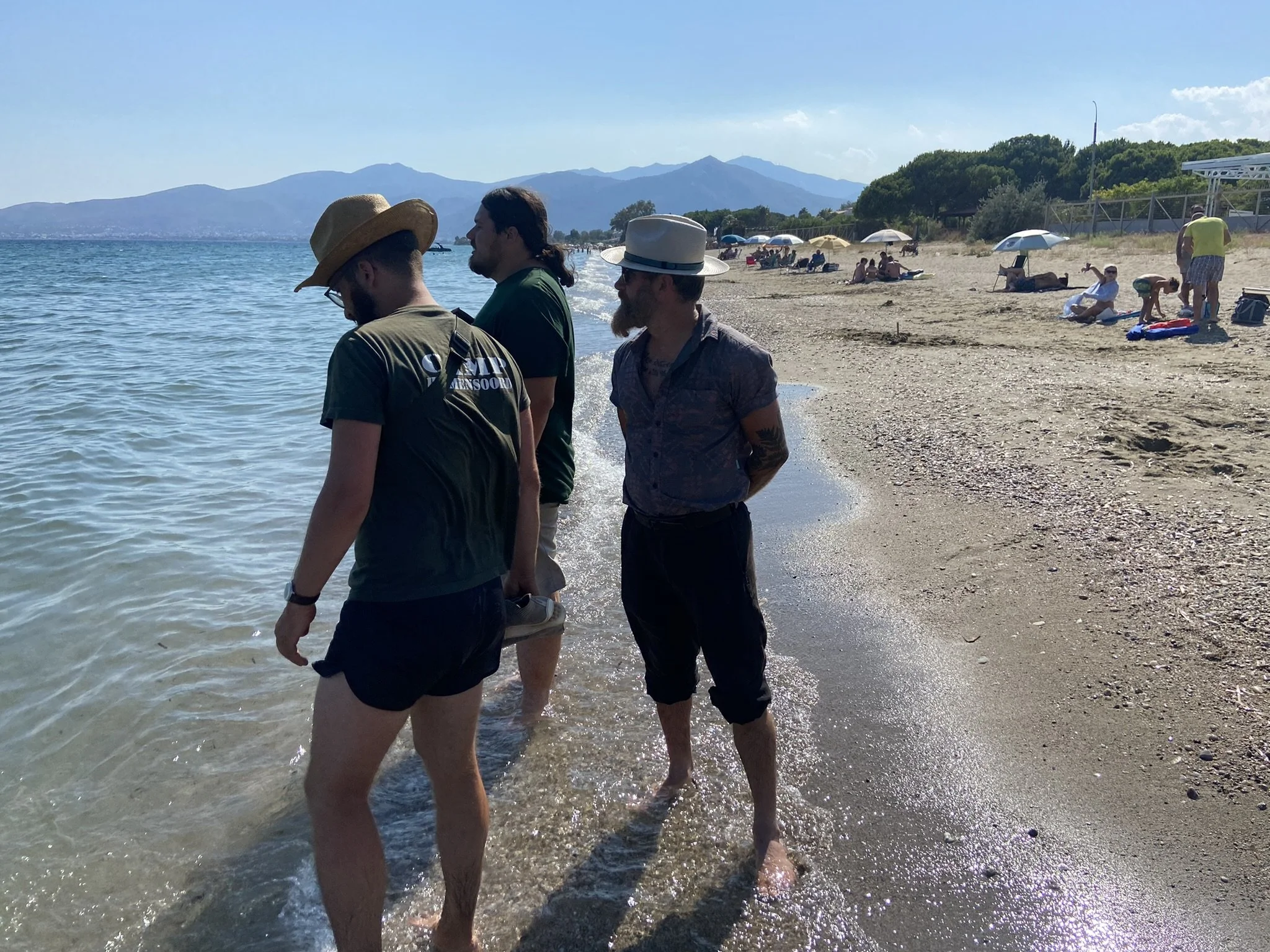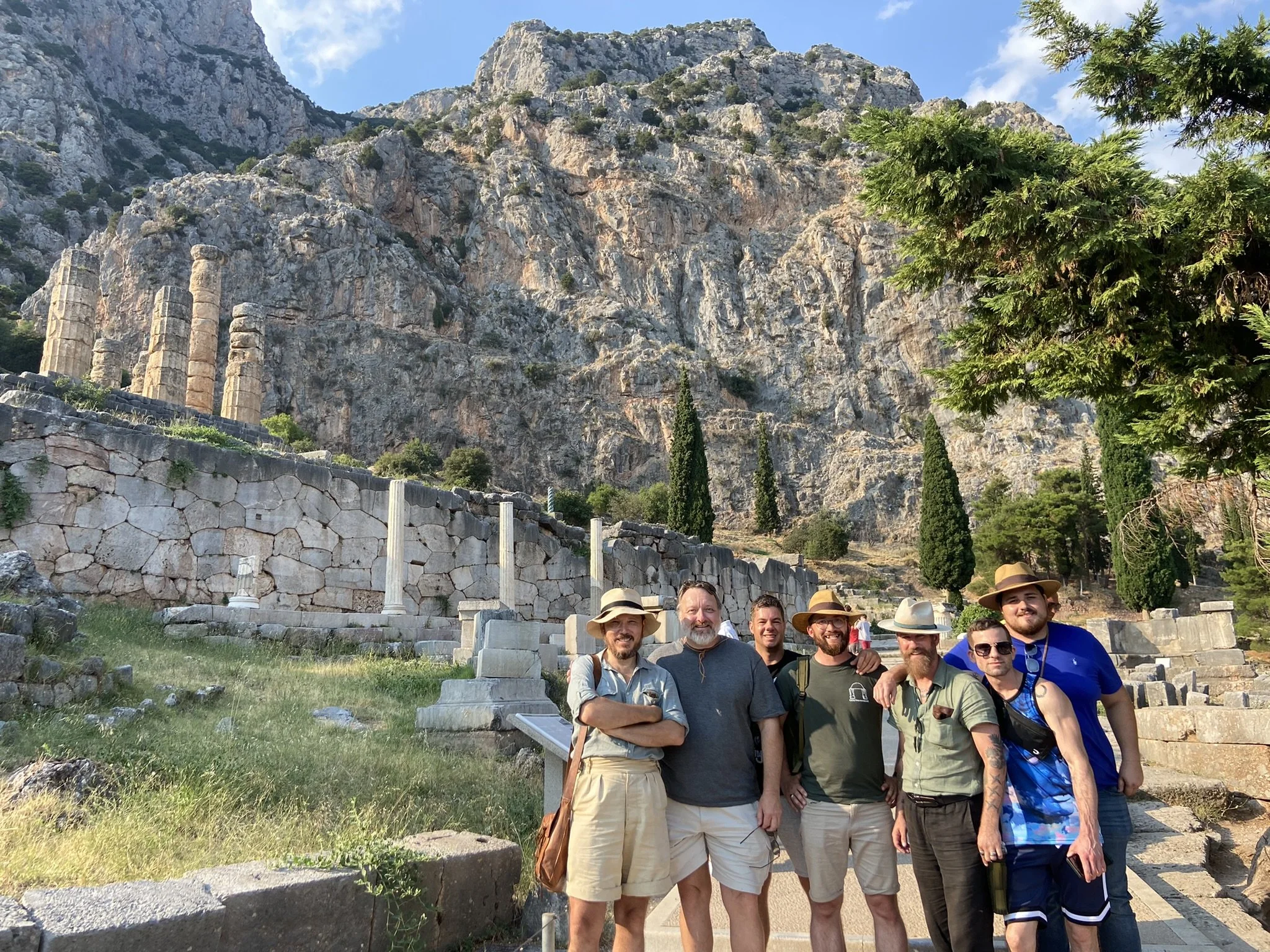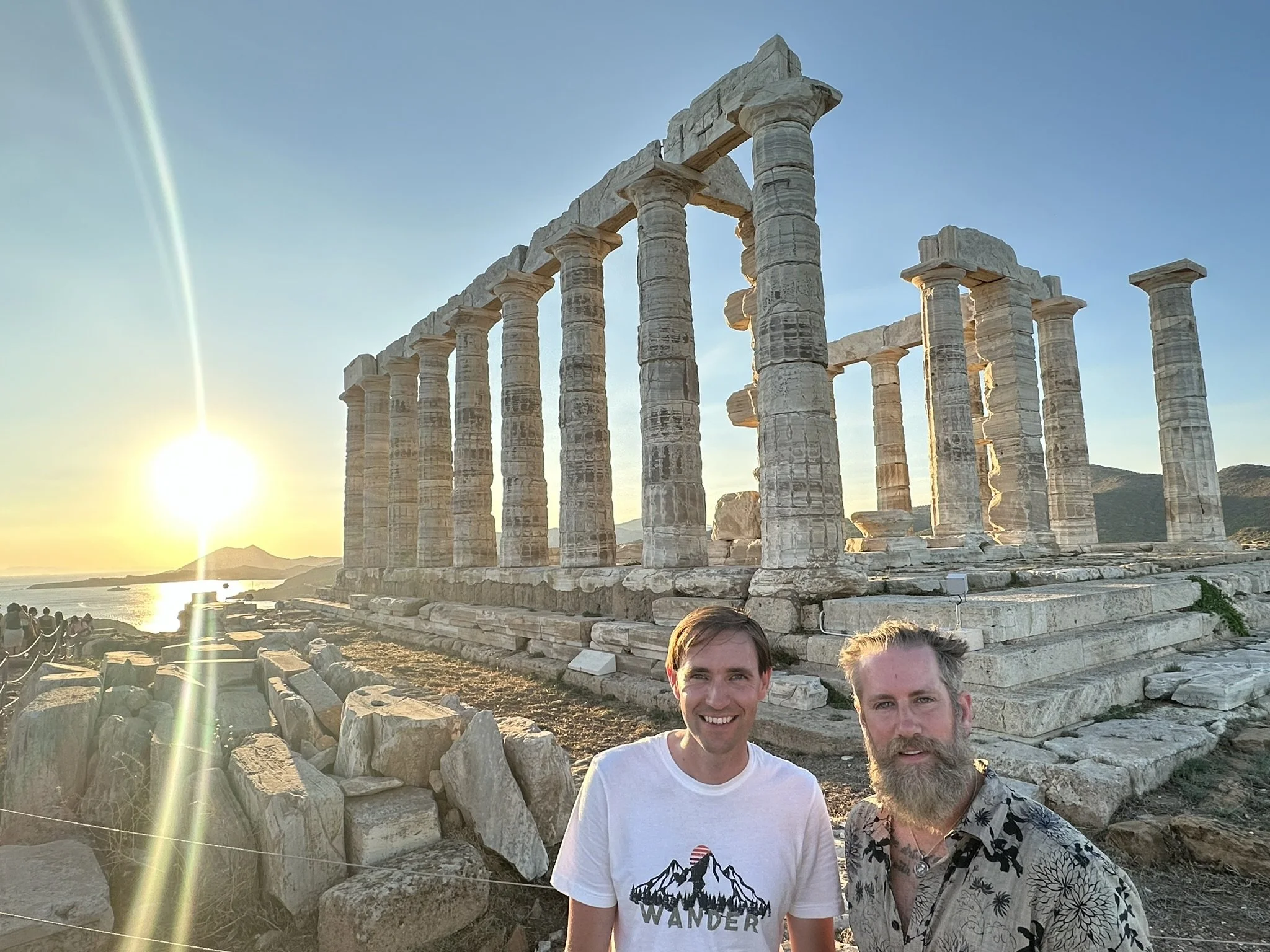Reenactment of the Battle of Pylos & Sphacteria (April 2027)
Following on the success of historical reenactments in Greece at Marathon (2011 and 2015) and Plataea (2022 and 2024), the planning committee for Pylos/Sphacteria 2027 is pleased to announce the next major Ancient Greek reenactment on the pristine site of one of the most unique, fascinating, and impactful battles of the Peloponnesian War.
Ancient Pylos seen looking north from the Spartan final position on the heights of Sphacteria. The Athenian commander Demosthenes established his tiny fort where the eastern cliffs of Koryphaison meet the beach isthmus near the center of the image. Spartan hoplites assaulted this position from their camp to the east and with a daring amphibious landing on the rocky western coastline, but both attacks were repulsed. The medieval ruins of Castle Navarino crowns the heights of Koryphaison, beyond which lies the Cave of Nestor and the crescent beach of Voidokilia.
Historical Background
The Battle of Pylos and Sphacteria in 425 BCE is a story of strategic and tactical audacity, combined sea and land operations, twists of fate, diplomatic intrigue, and hubris humbled – all in a compact, stunning location almost untouched by time. The battlefield today conforms very closely to ancient descriptions. Ancient Pylos (located on the far side of Navarino Bay from modern Pylos) consists primarily of a rocky mountain peninsula (called Koryphasion today) connected to the Messenian mainland by a beach-lined lagoon (formerly marshland). It was on the small beach just east of Koryphaison that the Athenian strategos Demosthenes landed his squadron of five triremes, establishing a base to encourage the defection of Messenian helots and generally be a thorn in Sparta’s side in the sixth year of the great Peloponnesian War between the two leading poleis of Greece.
The strategy worked, and the Spartan army withdrew from its annual ravaging of the Attic countryside to deal with the threat. The first phase of the battle involved a Lacedaemonian hoplite assault from the east combined with an attempted amphibious landing on the narrow rocky western coast. Both were repelled, with the capture of at least one Spartan shield – quite possibly Brasidas’ own – being retained as a trophy (still on display today at the Agora Museum in Athens).
Approximately 440 Lacedaemonian hoplites were garrisoned on the long island of Sphacteria directly south of Pylos as part of a blockade of Demosthenes’ outpost, but this strategy backfired when the Spartan fleet was defeated by the Athenians in a naval battle in the Bay of Navarino, trapping the hoplites and causing an extended stalemate as Spartan delegations to Athens sought to negotiate the return of their troops, which included approximately 120 full Spartiates.
The Athenians declined to give up their tactical advantage, and after Sphacteria was cleared of ground cover by a fire (probably lit at Demosthenes’ command), they landed a massive reinforcement force – mainly consisting of peltasts, slingers, and archers – on the island. Without light troops of their own to counter these fast and agile missile troops, the heavy Lacedaemonian hoplites were steadily worn down, and after Athenian-allied Messenian light infantry scaled the heights at the northern end of Sphacteria to appear behind the enemy position, the Spartans surrendered en masse, shattering the reputation they’d enjoyed since Thermopylae for fighting to the last man.
The Reenactment
The red arrow above marks the site of the Athenian fort. Our campsite is in Gialova to the east, on the site of the Spartan camp. The Spartan final position is on the heights at the northern end of Sphacteria.
We propose the following event schedule:
Monday April 19th, 2027 - Arrival on site; camp set-up.
Tuesday the 20th - Group excursion to Olympia and The Palace of Nestor.
Wednesday the 21st - Site exploration: Ancient Pylos, Koryphaison, Castle Navarino, Cave of Nestor, Voidokilia Beach. This will be a “civilian” day in comfortable hiking shoes and swimsuits. Perfect for families!
Thursday the 22nd - Private three-stage combat reenactment of 1) the Spartan land assault on the Athenian Fort, on location at the isthmus of Ancient Pylos, 2) Brasidas’ amphibious landing on location at the Rocks of Brasidas, and 3) The Battle of Sphacteria, held at a proxy location on the grassy hill above the Rocks of Brasidas. Each stage will involve tactics and experiments specific to that phase of the battle. This will be our “tactical” day with padded sparring weapons. Packed lunch of authentic “field rations” (e.g. maza, cheese, onions, dried fish and fruit).
Friday the 23rd - Excursion (in kit, with sharp weapons) to Sphacteria by private ferry. Modern footwear may be advisable for the hike to the final Spartan position, where we will have an extensive photo/video shoot. Packed “field ration” lunch.
Saturday the 24th - If there is local interest, we will hold our public demonstration and reenactment of all three stages of battle at Ancient Pylos OR conduct a public demonstration in modern Pylos or the medieval Castle of Pylos which overlooks it. Athletic competitions, an evening feast, musical performances, and a grand symposium will be held at camp.
Sunday the 25th - Camp breakdown and departure.
Dates are potentially flexible if we can get substantially better turnout at a different time, but late April will guarantee us the lowest rates. The schedule of activities can also be revised at the time depending on weather (Olympia and Nestor’s Palace being good rainy day activities).
Our base of operations will be the beachfront Erodios campground in Gialova (site of the Spartan camp), about a ten-minute drive or an hourlong march on the beach from Ancient Pylos. Participants will have the options of tent camping or staying in a private bungalow. Modern bathroom facilities offer hot showers, and food preparation facilities will allow us to make our own inexpensive and authentic meals. The village of Gialova itself is a resort with many restaurants and tavernas, but the focus of each day after scheduled activities will be an active camp life of authentic cooking, dining, drinking, athletics, and both musical and narrative performances (see the “Camp Life” section below).
Additional partners for the event may include the American archeological team excavating Nestor’s Palace just north of Pylos, the Invicta Youtube channel, and Ioanna Tsoucala — a Greek documentary filmmaker interested in exploring the world of ancient reenactment. Rachele Lori is on board to be the event photographer again!
For those who’d like to do some wider Ancient Greek tourism in advance of the event, we can organize group visits to locations in and around Athens, Pireaus, Eleusis, Corinth, Mycenae, Mantinea, and any other locations for which there is interest.
If you have questions, suggestions, or would like to register for the event, please contact Andrew Yamato at dayamato@gmail.com with: your name, group (if you’re part of one), impression(s), nation of residence, and email address. We need to get an approximate headcount in order to reserve sufficient space at the campground, so please let us know if you plan to attend!
Site Tour, Part 1: The Athenian Fort at Pylos
The primary location of the ancient battlefield is the Athenian fort established at Ancient Pylos by Demosthenes. A tiny enclave with room to beach only five triremes, its fortifications connecting the sheer cliffs of Koryphaison to the water were hastily improvised by the small squadron’s trireme rowers and initially garrisoned by as few as ninety hoplites. It nevertheless survived the battle and persisted as a beacon of hope for Messenian helots and an ongoing humiliation for Sparta until finally abandoned by the Athenians in 409. We will stage a reenactment of the initial Spartan assault on the fort here, with Athenians defending a small embankment that may mark the original location of the Athenian fortifications.
Looking southwest at the site of the Athenian Fort toward Sphacteria. The rocks in the water are of unknown origin but mark a likely location for the improvised fortifications built by Demonsthenes’ men from the cliffs of Koryphaison down to the beach.
Looking southeast into the Bay of Navarino. The rocks in the water mark the likely extent of the Athenian fortifications, leaving just enough room on the beach for Demosthenes’ five triremes.
Looking east from within the fort. The small embankment in the left center of the frame (in front of the parking lot) is perhaps the exact location of the Athenian fortified line.
Looking northwest at the embankment from the Spartan perspective. It will be defended by Athenian hoplites and peltasts against a Spartan phalanx in our first tactical scenario. (The visible wall elements are not ancient.)
Site Tour, Part 2: The Rocks of Brasidas
On the western side of Ancient Pylos is the forbidding coastline of jagged rock where the firebrand Spartan commander Brasidas unsuccessfully attempted a daring amphibious landing in the Athenian rear. While the razor-sharp rocks themselves are far too dangerous for reenacted combat, there is a large graveled enclosure slightly inland that provides a natural arena through which a “landing force” of Spartan reenactors will attempt to force its way (in mixed monomachia combat) to the beach exit past a screen of Athenian defenders in our second tactical scenario.
Looking north along the coastline at a possible landing point for Brasidas.
Looking south to Sphacteria.
Brasidas makes landfall!
The graveled enclosure through which the Spartans will advance.
The Spartan objective: a small beach exit to the grassy slope of the interior.
Site Tour, Part 3: The (Proxy) Battle of Sphacteria
Our third tactical scenario will reenact the famous climax of the battle on the island of Sphacteria on a proxy location: the grassy southwest slope of Koryphaison, just inland from the Rocks of Brasidas.
Looking northeast. The Athenian advance — led by peltasts and archers — will force the Spartan hoplites to retreat up this hillside, where they will make a final stand near the green shrubbery and dead trees.
Looking southwest from the Spartan “final position.”
Looking northwest from the Spartan final position. As the Spartan phalanx holds off the main Athenian force on the grassy slope, Messenian peltasts and archers, concealed by the vegetation along the slope, will make their way around the Spartan flank, eventually appearing behind them and attacking down this road.
Looking south from behind the Spartan final position (from the Messenian perspective as they make their final attack down the road), this is a panorama of our “Sphacteria” proxy battlefield, with the real Sphacteria looming in the distance. The Rocks of Brasidas and the graveled enclosure we’ll use for combat there is at right.
Continuing up the road brings us to the medieval ruins and magnificent views of Castle Navarino. We will not be using the castle in any of our scenarios.
Looking east from Castle Navarino along the narrow beach isthmus that leads to the Spartan camp at the modern resort town of Gialova (where we’ll be camping).
Looking north from Castle Navarino at the crescent beach of Voidokilia.
The massive Cave of Nestor looks out on Voidokilia Beach from halfway down the north face of Koryphaison.
Here be cyclops…
The Cave of Nestor and Voidokilia Beach were both used as appropriately Homeric locations for Christopher Nolan’s upcoming adaptation of The Odyssey. They remain completely undeveloped and unspoiled.
From Voidokilia Beach, the Athenian Fort at Demosthenes’ Beach is a twenty minute walk away along a narrow Thermopylae-like path along the eastern face of Koryphaison.
Site Tour, Part 4: Excursion to Sphacteria
A full day of the event will be devoted to exploring Sphacteria. We’ll be in full kit for this, but it may be advisable to bring sturdy hiking shoes for the ascent to the Spartan final position, where we’ll do an extended photo and video shoot on this most scenic and historic location.
The boat ride will take us past the single battlecruiser-shaped island in the Bay of Navarino, where the Athenians erected a trophy after their naval victory over the Spartan fleet.
At the landing point, near the location of the Spartan camp, a wooden chapel has been erected in memory of the Russian sailors killed in the 1827 Battle of Navarino. The island is otherwise natural and quite untouched by the passage of time.
The Spartan final position is reached by a long trail originally built by occupying Italian troops in WWII. It is considerably more rugged than this photo suggests.
A very happy Paul Bardunias at the Spartan final position. Behind him stretches the plain — deforested by fire at the time of the battle — through which the Spartans retreated before the Athenian light infantry.
Dr. Roel Konijnindijk, blown away by the view of Ancient Pylos.
A view of the northern slope of Sphacteria, through which the Messenians passed unnoticed to appear behind the Spartan final position.
The final Messenian route of ascent to the rear of the Spartan final position.
A rare photograph of Spartan helots swimming in with food supplies for the besieged garrison on Sphacteria.
Site Tour, Part 5: Our Campsite
We’d love nothing more than to camp right on the beach of Ancient Pylos, but it’s simply out of the question. The Greek government has recently passed legislation completely prohibiting “free camping” because of the fire risk. Fortunately, we’ve found the next best thing: a private campground at the western end of Gialova — the tourist village built on the site of the Spartan camp in 425. It’s the last bit of modernity before Ancient Pylos, which is a ten-minute drive (or a one hour march along the beach) away. While less rustic than the camps at Plataea, Erodios offers much greater convenience, simpler logistics, better security, and comfortable beach resort amenities for those needing a break from antiquity — especially families who’ve been dragged along!
The owner is a former sailor in the Greek Navy who was very receptive to what we want to do, and he’s happy to act as an advocate when the time comes to approach the Ephorate of Messenia and as a fixer with local businesses we’ll need to work with to make the event happen.
Pylos 2027 organizers Ilia Iatrou and Pablo Aparisi Galan with Thymios Panourgias, the owner of Erodios Campground on the beach at Gialova.
Erodios campground offers idyllic beach views of Sphacteria, Ancient Pylos, and the Bay of Navarino, where the Athenian navy bested the Spartan fleet in 425. The bay was also the location of a decisive naval battle in the Greek War of Independence.
Because the beachfront campsites are reserved by regulars years in advance, our main campground will be about 50 yards inland, in our own private section able to accommodate up to 80 campers. Modern bathrooms with hot water showers are immediately adjacent. 50 closed-circuit cameras monitor the fenced campground, so security won’t be an issue.
A private field next to the campground can be used for drill, exercises, demonstrations, and athletic competitions.
Although open flame is prohibited, two large grills on a central dining patio will allow us to prepare our own authentic food.
Food can be stored and prepped in a modern kitchen next to the grills.
Large recreational patios can accommodate everyone in case of foul weather.
A playground for children.
For families and those who prefer not to camp, there are a number of bungalows with private bathrooms which can affordably accommodate up to four (20e per person, per night).
Gialova has a lively beachfront main street lined with tavernas and seafood restaurants.
The sun sets on Spartan hopes for victory every night.
Camp Life
Over the course of such an extended event, many of the best memories will be made in camp, which will be transformed into a military encampment rich in all aspects of ancient culture. We will practice drill & maneuvers, conduct public presentations and demonstrations, hold athletic games, observe religious ceremonies, prepare our own authentic food, enjoy performances of ancient music by world-class musicians, listen to mythic rhapsodies, hold symposia late into the night, and in general enjoy the company of like-minded friends from around the world.
The camp at Plataea, 2022.
The trailblazing Spanish hoplite reenactor Eduardo Guillentello holds one of his famed symposiums.
The symposium wine chills in the psykter.
Incense offering to the gods.
Renowned lyrist Lina Palera conducts a lyre class for participants at the 2024 Plataea event.
Authentic akratisma (breakfast) in the field.
Tuna steaks for deipnon (dinner).
The staple of the Ancient Greek diet: maza — an unleavened barley bread.
Members of the French group Les Somatophylaques dominated the games at the 2022 Plataea event. Sivan Tumarkin has announced that he will once again be providing another prize amphora from Pithos Reproductions!
Musical guest Diego Pasti sets the marching pace with his aulos.
A public demonstration of “othismos” at Plataea in 2022.
Because of the critical role Athenian light infantry played in defeating the Spartan hoplites in the battle of Sphacteria, peltasts, archers, slingers, and other psiloi impressions will be highly encouraged.
Pylos will be the perfect opportunity to expound and defend your theories on ancient warfare among kindred spirits.
The resort location will make this an especially family-friendly event.
A beach break will be just steps away whenever you need one.
Road Trip Sightseeing
Greece is a small country, with the majority of ancient sites clustered in Attica, Boeotia, and the Peloponnese — all within a few hours drive of Athens. We encourage everyone to visit as many other battlefields, ruins, and museums as possible on your way to and from Pylos. In the past we’ve organized caravans so more of us can enjoy these sites together, and we’re happy to do so again. Your fellow reenactors will never ask you to hurry up at these places!
Every trip to Greece starts with Athens, and probably the Parthenon. The scaffolding is now down for the first time in decades.
The National Archaeological Museum is just one of many outstanding collections of Archaic and Classical art and artifacts.
Mycenae.
The plains of Plataea.
The Leuctra Monument.
The beach at Marathon.
The Temple of Apollo at Delphi.
The battlefield of Chaeronea.
The Lion of Chaeronea, on the burial ground of the Theban Sacred Band.
The battlefield of Mantinea.
Simonides’ inscription on the site of the Spartan last stand at Thermopylae.
Because it’s only two hours away from Pylos, the Museum at Olympia will be scheduled as part of the Pylos event.
The stadium at Olympia.
Especially because of its relative proximity to the Athens airport, sunset at the Temple of Poseidon at Sounion is a great final stop on any tour of Greece.
